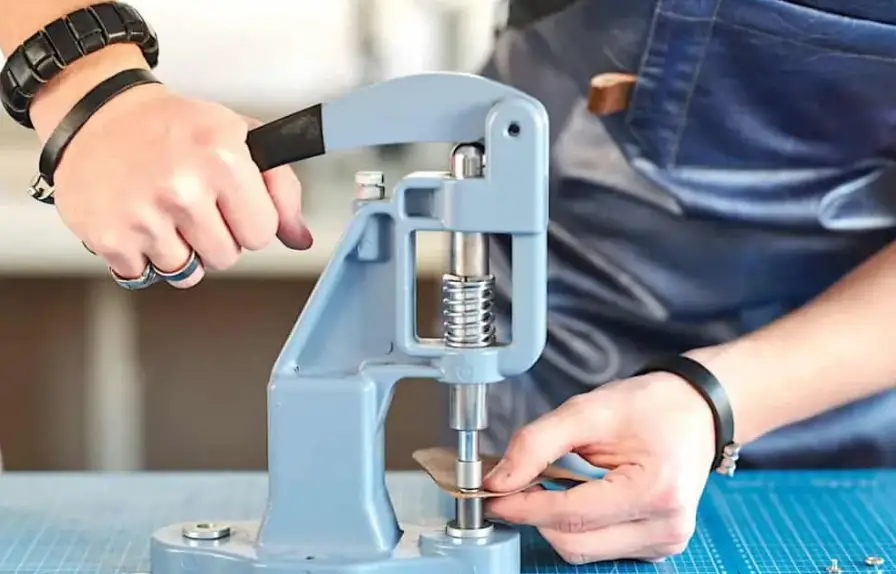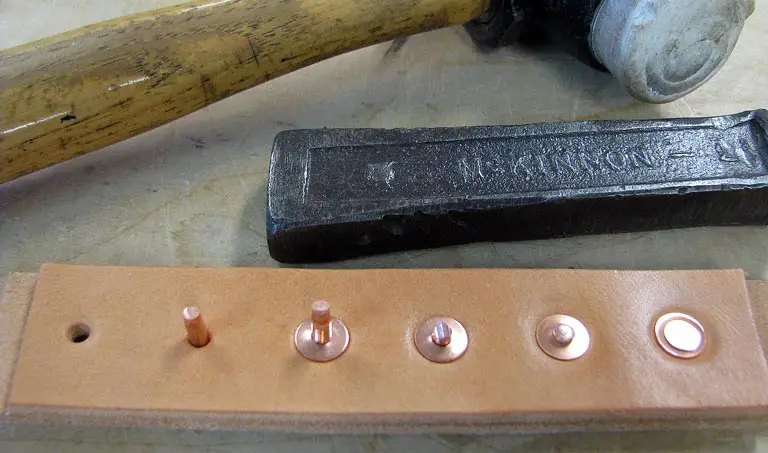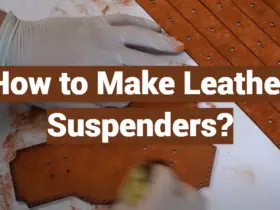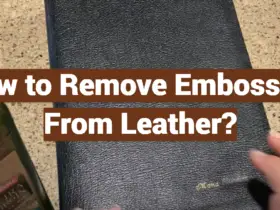Riveting leather is a great way to keep it together and look good for years to come. Here we will cover the basics of how to rivet leather, including what supplies you’ll need, the steps involved, and some tips to make the process go as smoothly as possible. So whether you’re new to leatherworking or just want to learn how to rivet leather like a pro, read on!
What Are Leather Rivets?

Leather rivets are metal fasteners used to hold two pieces of leather together. They come in a variety of shapes and sizes, with some having small decorative heads or different finishes. When they are properly inserted into the material, they provide a strong bond that can withstand wear and tear over time. [1]
Types of Leather Rivets
Leather rivets come in a variety of sizes, shapes and styles. Commonly used leather rivets are dome-head rivets, nail-head rivets, and flat-head rivets. Dome-head rivets have a rounded top to their heads which provides an aesthetically pleasing look to the finished product. Nail-head rivets are designed with sharply pointed heads, making them particularly useful for securing thicker pieces of leather together or providing additional strength to the material being fastened. Finally, flat-head rivets provide a flush finish and are commonly used when a low profile is needed for the finished product.
Leather Double Cap Rivets
Double cap rivets are one of the most common and versatile types of rivets used in leatherworking.
They come with two heads, a large dome-shaped head on one side and a smaller flat head on the other. This makes them ideal for applications where aesthetics are important since it provides a clean and professional look. They also provide extra strength since the two heads help to spread out the stress placed on them when they are inserted into the material.
Leather Single Cap Rivets
Single cap rivets are similar to double cap rivets except they have only one head, usually a dome-shaped head. These are great for applications where a lower profile is needed since they provide a flush finish with no protruding parts. They also require less force to insert them into the material making them easier to work with.
Leather Tubular Rivets

Tubular rivets are another type of popular leather rivet. These are cylindrical and have two heads, one dome-shaped head and one flat head. They provide a strong bond but also allow for more flexibility since they can move around inside their own holes without breaking the bond.
Common Leather Rivet Materials
Leather rivets are typically made from brass, copper, and aluminum. Brass is generally the most expensive but also extremely strong and durable which makes it ideal for applications that require extra strength. Copper provides an excellent balance between strength and price and is the most common material used in leatherworking. Aluminum is the least expensive option but can still provide a strong bond if properly inserted.
Leather Rivet Sizes and Uses
Leather rivets come in a variety of sizes, from small 1/8 inch diameter rivets to large 3/4 inch diameter rivets. The size you choose will depend on the application, as larger rivets are better suited for thicker materials while smaller ones are better for thinner materials.
Cap Size
The two main types of caps for leather rivets are dome-head and flat-head. Dome-heads provide a more pleasing aesthetic while flat-heads provide a low profile finish.
The size of the cap is also important because it needs to be large enough to spread out the stress placed on it when inserted into the material without being too big so that it doesn’t fit through the hole.
Post Size (length)
The post of a leather rivet is the part that goes into the material and should be long enough to provide a strong bond without being too long so that it protrudes out the other side. The length of the post will depend on how thick the material is, with longer posts being better for thicker materials and shorter posts being better for thinner materials.
How to Set Leather Rivets
Setting leather rivets requires a few specialized tools. The most important tool is an anvil, which is used to flatten the dome-head of the rivet after it has been inserted into the material.

Other tools such as a setter, hammer, and punches are also required and can be purchased at any leatherworking supply store. Once all the necessary tools have been gathered, follow these steps to properly set a leather rivet:
- Insert the post of the rivet through both layers of material.
- Place the head of the rivet over its corresponding hole in the anvil and hammer lightly until it is securely seated.
- Place a punch or setter over the top of the dome-head and give it a few light taps until the dome is flattened.
- Trim off any excess post material with scissors or a sharp knife.
Following these steps will ensure that your leather rivets are properly set and secure for long-lasting results. [2]
Helpful Leather Rivet Insights
When setting leather rivets, it’s important to use the correct size for the application. If the rivet is too small for the materials being used, it won’t have enough holding power and could easily be pulled out. Conversely, if the rivet is too large for the material it can put stress on the fabric and potentially tear or damage it.
Finally, remember to practice safety when working with leather rivets. Always wear protective eyewear and gloves when hammering and make sure to work on a flat, sturdy surface free of debris.
Will Pop Rivets Work on Leather?
Pop rivets are not suitable for use on leather due to their lack of strength and durability. Pop rivets should only be used on metal, plastic, or other non-porous materials, as the material may tear or degrade if it comes into contact with the pop rivet. Leatherworking requires strong, durable fasteners that can handle any force applied to them, so traditional leather rivets are the best choice for securing two pieces of leather together. With a bit of practice and determination, you can easily learn to place leather rivets perfectly every time! [3]
How Do You Rivet Thick Leather?
When riveting thick leather, it’s important to use the correct size of rivet for the application.
For thicker material, longer posts and larger caps are needed to spread out the stress placed on the rivet when inserted into the material. To ensure a smooth and strong finish, it is imperative to make sure all of your tools are sharpened and well-maintained before riveting thick leather; otherwise, a worn punch or anvil can create unattractive results while simultaneously weakening bonds.
To ensure your safety and the perfect results, don’t forget to follow all safety protocols when working with fasteners and always wear protective eyewear and gloves. With a bit of practice, you can set flawless leather rivets each time!
What Size Rivet Do I Need for Leather?
When choosing a rivet to use for leather, the size of the rivet should be determined by the thickness of the material you are attaching. If you are working with thin leather (1/16 inch or less), then a 2mm diameter rivet will work best. For medium-thickness leather (1/8 inch to 3/16 inch), choose a 3mm diameter rivet. For thicker leather (3/16 inch or more) choose a 4mm diameter rivet. The length of the rivet should also be considered – make sure it is long enough to accommodate both pieces being joined securely.
What Rivets Should I Use on Leather?

When working with leather, the best type of rivet to use is a traditional dome-head rivet.
Dome-head rivets are usually made of brass or copper and feature a flat top that is hammered down over the post. This provides a secure fit, while still being aesthetically pleasing. When selecting the size of your rivet, make sure that it is appropriate for the material you are using and always test fit before hammering it into place. Traditional dome-head rivets provide an easy way to securely fasten two pieces of leather together for long-lasting results. Overall, they are an excellent choice for all types of leatherworking projects! [4]
FAQ
Can you do leather rivets by hand?
Yes, you can do leather rivets by hand. However, it is important to make sure that all of your tools are in good condition before attempting to set a leather rivet. A dull punch or anvil can lead to an uneven finish and weakened bonds, so always make sure you have sharp tools on hand when working with leather. Additionally, remember to practice safety when working with any type of fastener and wear protective eyewear and gloves at all times. With a little practice and patience, anyone can easily set perfect leather rivets every time!
What size hole is used for leather rivets?
The size of the hole needed for a leather rivet depends on the thickness and type of material being used. Generally, thicker materials will require a longer post and larger cap than thinner materials. For example, if you are using two layers of thin leather, a 1/8” hole should be sufficient. If you are using thicker material such as thick suede or multiple layers of leather, then you may need to use a larger size such as a 5/32” hole. It is also important to make sure that all tools used in the process are sharp and in good condition to achieve the best results possible.
Can you install rivets without a rivet gun?
You don’t need a rivet gun to install rivets! The traditional method of setting rivets is to use a hammer and anvil or punch. A hammer is used to flatten the cap of the rivet while the anvil or punch provides support beneath the material to ensure that thick leather remains in place during the process. Although this method may take longer than using a rivet gun, it is just as effective at providing strong and secure bonds between two pieces of leather. Additionally, since no power tools are needed, this method allows for easy portability and convenience when doing on-the-go repairs.
How much weight can a rivet hold?
The amount of weight a rivet can hold depends on its size and type. Generally, small-diameter rivets can hold up to 20 pounds while larger-diameter rivets can hold up to 100 pounds or more.
Additionally, the type of material being used will also affect how much weight the rivet can support. For instance, when using leather, you should choose a heavier gauge than when using lighter materials such as canvas or fabric. In any case, it is always important to test the strength of the bond before applying any significant amount of weight. This ensures that your project remains secure for years to come!
Are rivets stronger than screws?
Rivets and screws both have their strengths and weaknesses. Generally, rivets are stronger than screws in terms of sheer weight capacity due to the way they spread out the force when hammered down. On the other hand, screws offer superior adjustability and can be tightened or loosened with ease depending on the situation. Ultimately, it depends on what type of job you are attempting and which fastener is best suited for it. Both types of fasteners can provide secure bonds if used correctly, so make sure you choose wisely!
Do rivets loosen over time?
Rivets can loosen over time if not properly secured initially. The key to ensuring that your rivets remain secure is to use the correct size and type of rivet for the job, as well as make sure they are properly hammered down before being tested. Additionally, it is important to check your rivets periodically to ensure that they have not become loose or worn out over time. If any signs of wear or loosening are noticed, then you should replace the rivet immediately. This will help keep all of your projects looking and performing their best!
Useful Video: How to Rivet Leather for Binding
Conclusion
Leather riveting is a skill you won’t regret learning, as it can help to breathe new life into old clothing and furniture! It’s a fun, practical way of giving old items a facelift and is also cost-effective. Plus, it gives you the satisfaction of creating something without needing specialist tools or machinery. Take the time to practice and play around with your tools until you’re comfortable enough to start doing some real upcycling! With this knowledge in your arsenal, tackling an upcoming project should be easy peasy. Before long, you’ll find creative ways to use leather rivets in easy DIYs. Whatever adventurous path you choose – from fashion to interior design – riveting can add style and structure. Remember: practice makes perfect! So don’t be intimidated if you don’t get it right away — with patience, you’ll soon become an accomplished leather riveter!
References
- https://www.libertyleathergoods.com/leather-rivets/
- https://www.libertyleathergoods.com/how-to-rivet-leather/
- https://www.libertyleathergoods.com/how-to-rivet-leather/
- https://leathersmithdesigns.com/blogs/how-to-rivet-leather/







Leave a Reply